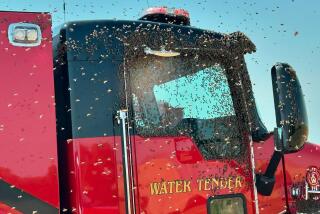Business Is Buzzing for Arizona Beekeepers : Safety: Two deaths blamed on Africanized ‘killer bees’ prompt many calls to remove hives from or near homes.
- Share via
PHOENIX — Bill Cote and Tom Richey prowl the night like burglars. But they don’t break in unless they’re sure everyone is home.
Cote and Richey don’t leave with TVs or VCRs--they haul away hives of bees.
And the pair, as well as their competitors throughout the area, have been busy since an Apache Junction woman died Oct. 10 after being stung nearly 1,000 times by Africanized “killer bees.”
And the death soon after of a Cave Creek man who was stung more than 100 times by Africanized bees is certain to keep people flipping to “Bee Removal” in the Yellow Pages.
“People are paranoid about bees,” Cote said during one of his nightly rounds. “They see a bee in their yard and they go ballistic.”
*
That paranoia means a rush business for Cote and other beekeepers at a time when bee activity traditionally slows down.
Cote, co-owner of S.R.B. Beekeepers in Mesa, has removed 35 to 40 hives a week recently. Two or three calls a week are more typical.
Bob Chapman, owner of Valley Bee Control in Mesa, is in the same boat.
“Normally this time of year, I’m doing three, four bee calls a week,” he said. “Now, I’m doing five a day.”
People are more concerned than they used to be, Chapman said, “and they don’t try to handle removing the bees themselves.”
The hive hanging in a Chandler pecan tree on a recent night was too high for the homeowners to try to remove themselves. Too high and too huge.
“There are a good 80,000 bees here, at least,” said Richey, dressed in a baggy white bee suit and standing on a ladder, 35 feet above the ground.
A crawling clump the size of two basketballs is wrapped around a branch of the tree.
Working by the light of a flashlight attached to another limb with duct tape, Richey dismantles the hive, brushing bees off the wax and into a wooden hive box.
Richey and Cote work at night because that’s when all the bees are home.
“If you do it during the day,” Cote said, “you’ll leave 30% to 40% of the bees behind.”
Bees defending the hive attack the lens of Richey’s flashlight, but things go smoothly until a chunk of hive breaks off and drops.
“You’re on your own,” Cote shouts to Richey as he high-tails it out of the back yard.
Richey, who usually gets stung once or twice a night, is stung through the bee suit more than 10 times. Things are calmer during a call at a Chandler park, where about 3,000 bees are homesteading in a below-ground meter box.
“It’s dark and cool and damp,” Cote said, “and that’s what they like.”
Richey--it’s his night in the bee suit--lifts the lid and simply scoops the bees into the hive box. Once the queen is in the box, most of the bees try to crawl into it on their own.
*
Cote and Richey made six more calls, working until 3 a.m. Most of the 100,000 bees collected that night will go to work for Cote, producing honey, wax and pollen that he sells. Cote sometimes sells hives to other beekeepers.
The increase in calls means more insect recruits for others, and although beekeepers are happy for the business, Keith Meyer of the Arizona Department of Agriculture said there’s no reason for people to fear everything that buzzes.
“Bees belong on flowers,” he said. “But if you see bees crawling into the walls of your house or building a hive beneath your eaves, you might want to call someone to remove them.”
More to Read
Sign up for The Wild
We’ll help you find the best places to hike, bike and run, as well as the perfect silent spots for meditation and yoga.
You may occasionally receive promotional content from the Los Angeles Times.






